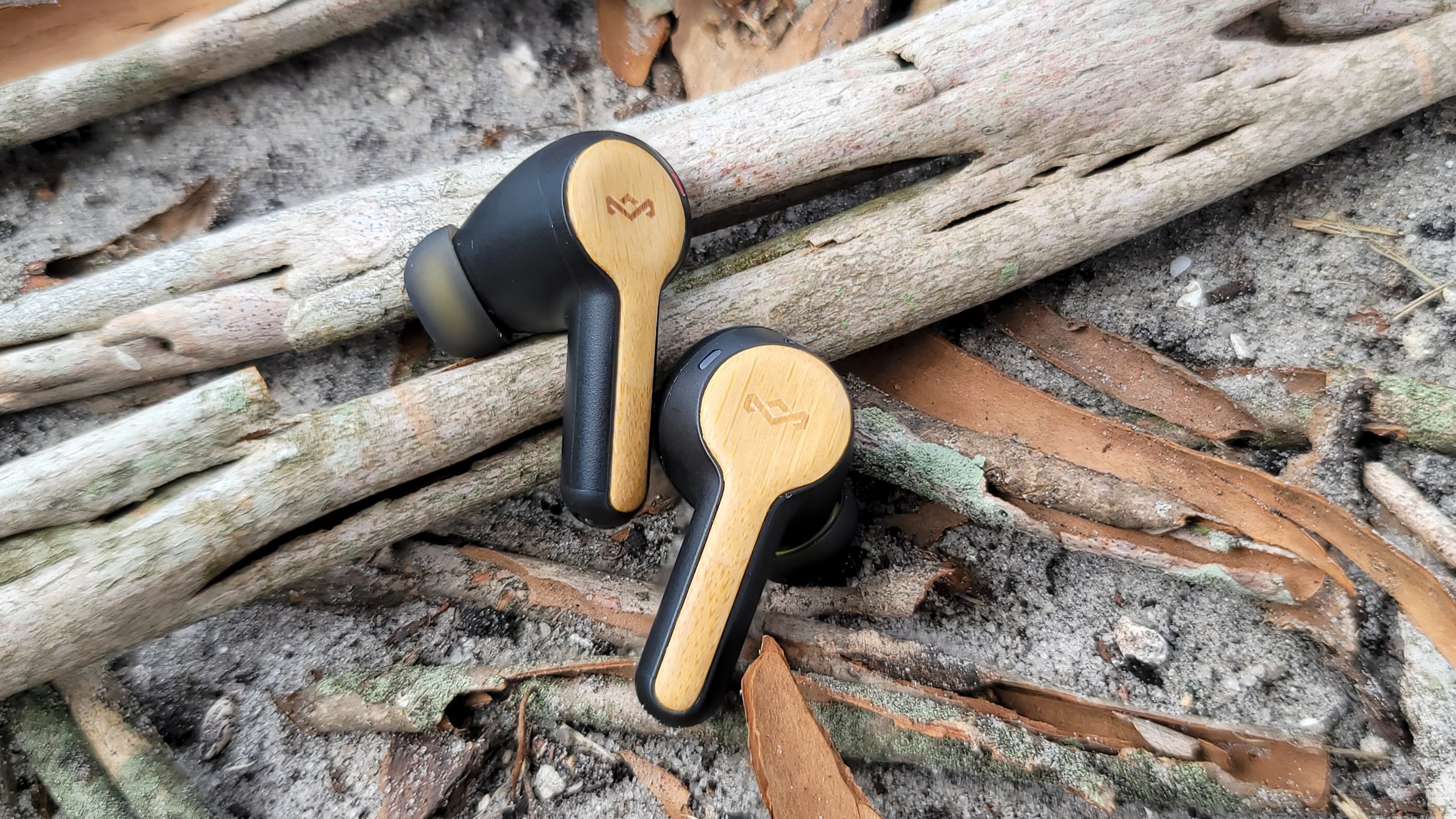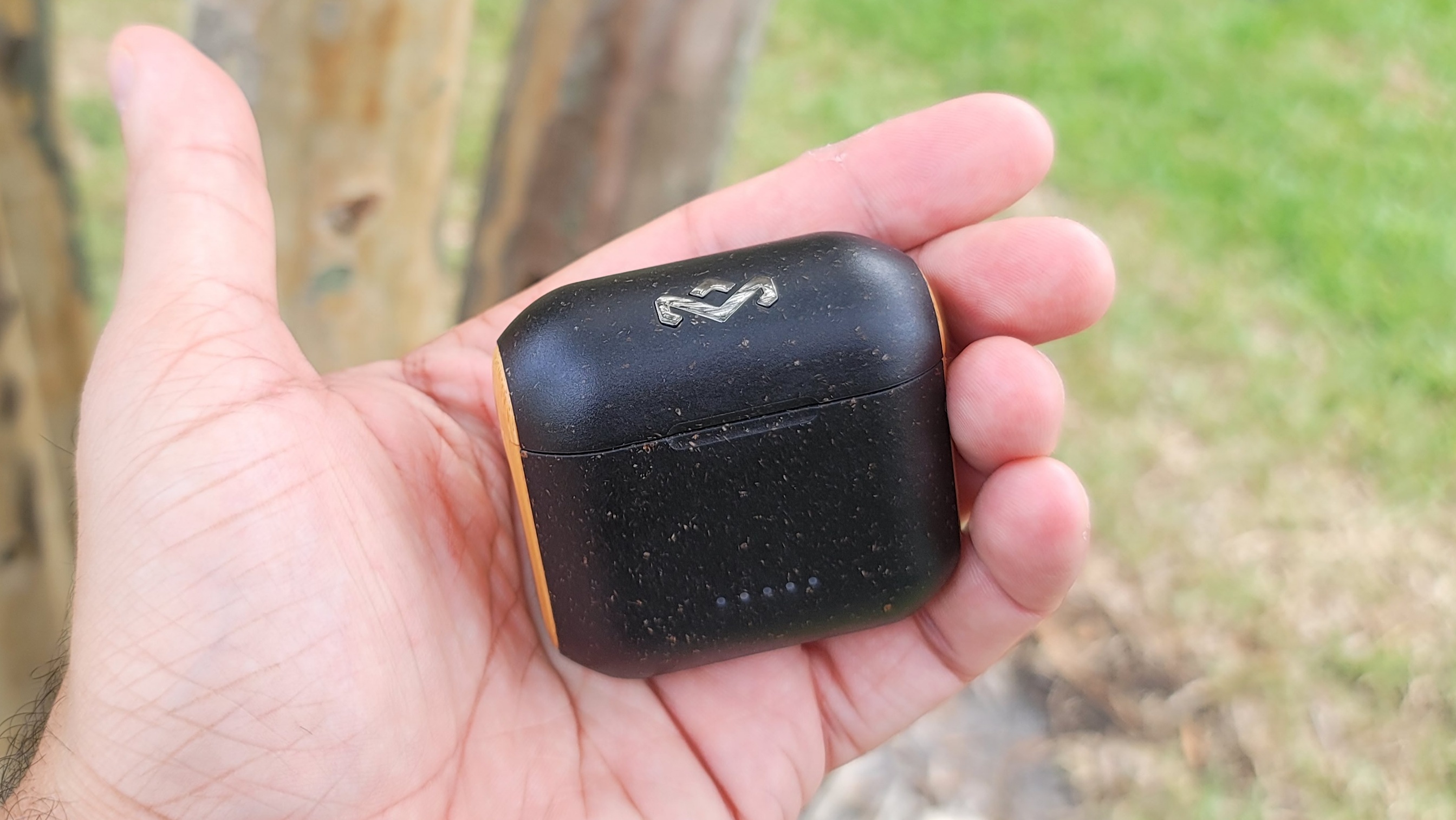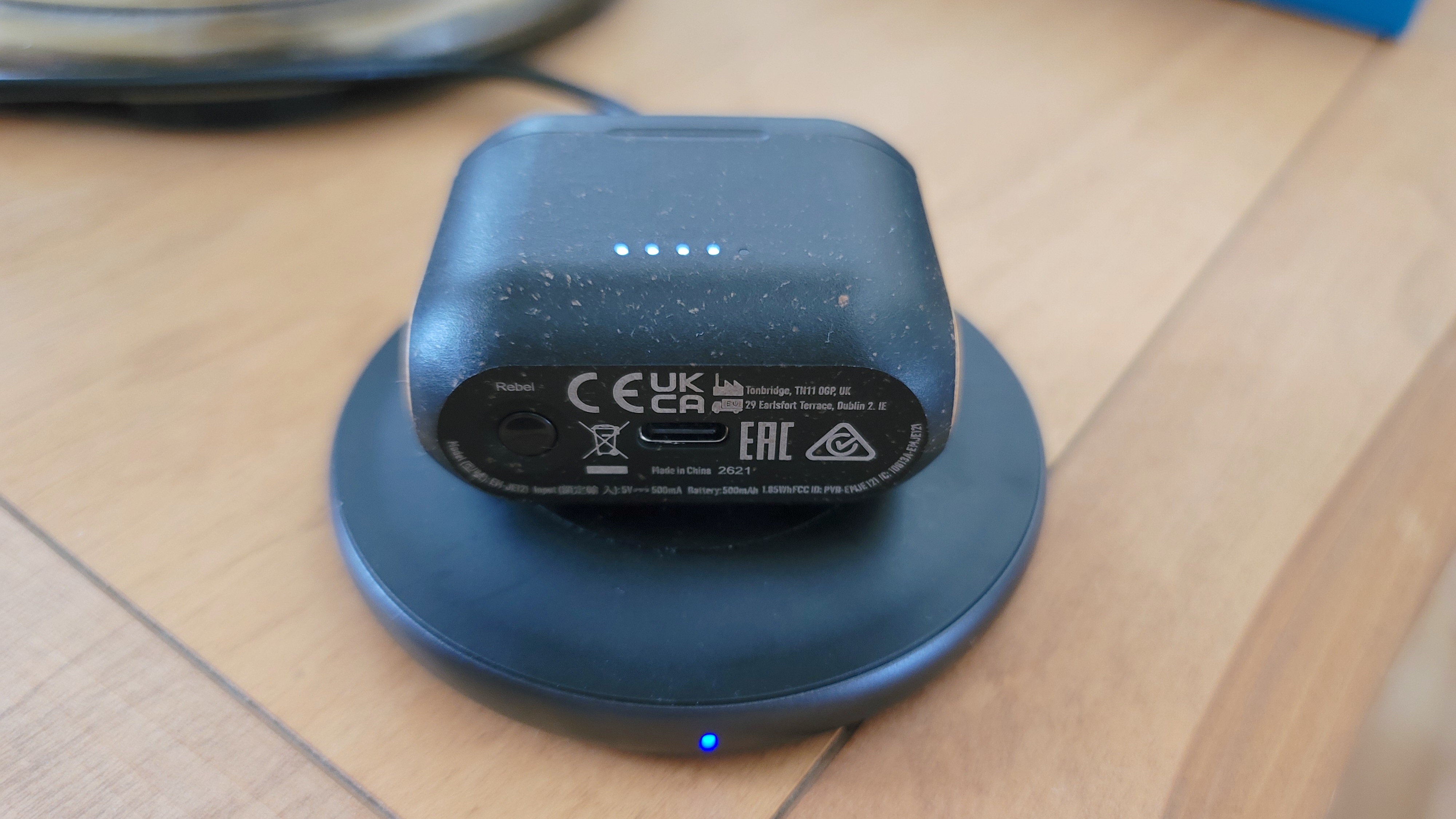Laptop Mag Verdict
The House of Marley Rebel nails brand hallmarks such as strong sound and sustainable packaging, but other key areas require improvement.
Pros
- +
Warm, deep sound
- +
Attractive eco-friendly design
- +
Long battery life
- +
Built-in equalizer settings
- +
Strong connectivity
Cons
- -
Awkward, finicky touch controls
- -
Weak call quality
- -
Uncomfortable
Why you can trust Laptop Mag
House of Marley is gradually becoming a household name in the audio space. Several of their products have been well received by critics and consumers, and though performance is a highlight, it is the brand’s push for sustainability that distinguishes them from the competition. Everything from their wireless headphones to their USB turntables is composed entirely from recycled materials, leaving a small manufacturing carbon footprint that impacts the environment in positive ways. This trend continues with the all-new Rebel true wireless earbuds.
- Our expert picks for the best wireless earbuds, per budget and style
- Check out our Apple AirPods Pro review
- …and our Sony WF-1000XM4 review
The latest entry in HoM’s TWS lineup is part of a special collaboration with singer-songwriter and grandson to Bob Marley, Skip. It offers bass-heavy sound, stable connectivity, and sufficient battery life in a premium, eco-conscious design. Unfortunately, these buds also have several shortcomings that may or may not sway you to look at other relatively affordable options.
House of Marley Rebel True Wireless Earbuds review: Availability and price
The House of Marley Rebel can be purchased for $129 in Black or White directly from House of Marley. Inside the box comes a wireless charging case, USB-C charging cable, quick start guide, warranty booklet, and three different sizes of ear tips.
These wireless earbuds come in at a lower price point than sub-luxury favorites like the Samsung Galaxy Buds Pro ($169) and Beats Studio Buds ($149), plus category leaders such as the AirPods Pro ($249) and Sony WF-1000XM4 ($279). FYI: all those have bigger feature sets.
If you’re in the market for something cheaper and with more functionality, we recommend two Anker models that come with active noise cancellation and companion app access: the Life P3 ($79) and Liberty Air 2 Pro (on clearance for $84.99 at Best Buy).
House of Marley Rebel True Wireless Earbuds review: Design and comfort
Like its predecessors, the Rebel is a chic-looking pair of buds built from eco-friendly materials, including bamboo, natural wood fiber composite, and recycled plastics. Even the packaging is 100% recyclable. Craftsmanship is sturdy with a solid plastic frame and smooth wooden accent on the front. These buds can also fend off different types of damage, thanks to IPX5 certification for water, sweat, and weather resistance.

Despite having a similar design to its more expensive sibling, the Redemption, the Rebel has more distinction to it. The embedded logo, slightly darker shade, and grainier appearance on the bottom half of the stems serve as proof.
Sign up to receive The Snapshot, a free special dispatch from Laptop Mag, in your inbox.
As expected, the compact charging case is built from the same materials as the buds, mostly wood and plastic. There are some nice details to it such as the embedded silver logo and indents on the side to conveniently grab and pull out of your pocket. Construction doesn’t feel as high quality as some of HoM’s other charging cases. Furthermore, the lid is super-flimsy and won’t protect the buds much should the case ever hit the ground.

Comfort wasn’t as pleasant as I would have liked either. The slanted driver design presses up against the concha, something you’ll feel within 30 minutes of wearing of the buds. My ears needed a breather after about 1 hour and 40 minutes, due to soreness.

HoM gives you three sets of silicone ear tips (Small, Medium, Large) to accommodate different ear shapes. The tips provided a decent seal around the canal that kept the buds in place whenever moving around.
House of Marley Rebel True Wireless Earbuds review: Touch controls and digital assistant
Users can enable playback, call management, volume, digital assistance, and EQ activation on these buds. However, the control scheme is a little wacky and input methods aren’t as responsive as on other models.
This is the first pair of wireless earbuds that I’ve tested without any press or tap gestures assigned for play/pause. On-ear detection takes care of these two functions, meaning you’ll need to remove the buds to auto-pause and place them back on to auto-play. I’m grateful for the motion detection, and it is the one function that works well, but it just seems more practical to pause music with a single tap gesture. Oddly, that input method is reserved for volume, letting you increase/decrease sound on the left/right bud.

A double tap will either skip (left bud) or play the previous track (right bud), while a triple tap cycles through the three different EQ modes and the press-and-hold gesture activates the digital assistant. The multi-tap functions are often misinterpreted, and the touch panels don’t always register them.
Siri, Google Assistant, and Bixby all work with the Rebel. The mics pick up vocals very well and each AI bot recognizes and responds to inquiries quickly. You will deal with some lag whenever enabling the feature; Siri takes about 2 seconds to activate.
House of Marley Rebel True Wireless Earbuds review: Audio quality
Sound quality on HoM headphones and earbuds has been consistently entertaining. The Rebel comes with two swappable EQs – Signature and Bass Boost – as well as 10mm drivers, producing a warmer and punchier soundstage than the inexpensive Champion. What came out of the buds was enjoyable, though I felt the emphasized bass in Signature mode often hindered the mids and highs. Turning on Bass Boost brought them down another notch.
One of the few occasions where the Rebel demonstrated excellent frequency range was on melodic tracks like Bob Marley & The Wailers’ “Could You Be Loved.” The bass and guitar strums had some nice bounce to them, while Marley’s demanding vocals carried well over the disco-friendly production. I also found the instrument separation fantastic, letting me hear the guitar, drums, acoustic piano, and unique musical tools like the Brazilian cuíca distinctly.

Bass Boost certainly lived up to its moniker when blasting boom-bap classics such as KRS-One’s “Outta Here.” My eardrums were pummeled with deep upright bass and slamming drums. As the low end increased, I worried that vocals would distort, but that wasn’t the case. However, I could hear the lack of clarity on the sampled Slick Rick hook.
A middle ground was reached when listening to Jazz records, as the buds delivered a bit of everything, no matter what mode was enabled. The double bass on Ahmad Jamal’s “The Awakening” had stellar reverberation, which intensified when Bass Boost was activated, and the steadily tapped cymbals remained prominent throughout the recording.
Noise isolation isn’t the greatest. Therefore, you won’t hear audio fully since ambient noises creep onto the soundscape. Active noise cancellation could have helped, but the feature is exclusive to the Redemption.
House of Marley Rebel True Wireless Earbuds review: Battery life and charging case
Playtime hasn’t changed between the Champion and Rebel: 8 hours on a single charge. Factor high volume, streaming, and EQ use into the equation, it drops by about 30 to 45 minutes. Not bad at all, especially since there are several luxury ANC models like the AirPods Pro (4.5 to 5 hours) and Bowers & Wilkins PI7 (4 hours) that underperform in this category.
Keep in mind that there are other wireless earbuds that surpass the Rebel in battery life: the WF-1000XM4 (8 to 12 hours) and Master & Dynamic MW08 Sport (8 to 10 hours) come to mind. Granted, the amount of playtime given by HoM is some of the highest at the sub-$120 price point. This is enough for 4 days of casual listening (2 hours daily) before recharging.

The charging case also holds a vast amount of playtime at 30 hours. You’re looking at about 3 to 4 extra charges. A quick charge can earn you 1 hour on a 15-minute charge.
Wireless charging makes its way onto a pair of HoM wireless earbuds for the first time, letting you juice up the buds whenever placing the case on a qi-enabled charging pad.
House of Marley Rebel True Wireless Earbuds review: Call quality and connectivity
HoM uses what it calls echo noise cancellation to “remove background noise and improve call quality.” The Rebel does neither. Using the buds outside, I had a few callers describe my voice as distant and muffled, while also pointing out loud noises (e.g., gates, whisking cars, wind) in the background. When entering the house, my wife noticed a minor improvement in volume, but stressed that muffling was still an issue.

Bluetooth 5.0 maintains a strong connection and allows for quick pairing with devices. There is also a pairing button at the bottom of the charging case in case you ever need to do it manually. Range is lengthy at 45 feet; I maneuvered from room to room without any dropout or stutter occurring on calls or Spotify sessions.
Multipoint technology isn’t available, so you won’t be able to connect the Rebel to two devices at the same time.
House of Marley Rebel True Wireless Earbuds review: Verdict
The Rebel retains much of what makes HoM products special. Design-wise, you must respect the effort put into creating such a stylish pair of wireless earbuds from recycled materials. Audio is impactful enough to satisfy bass lovers, and though it comes at the expense of clarity, you’ll still get a full dose of lows, mids, and highs on certain tracks. Having up to 8 hours of listening time and wireless charging at your disposal is beneficial as well.
Accolades aside, HoM took a few wrong turns when developing the Rebel. The adjustments in sound might be forgivable for some people, but the discomfort, inaccurate controls, and unsatisfactory call quality are not.
Truthfully, I find the Champion to be the better HoM investment because of its refined sound and unbeatable MSRP ($69). That isn’t to say fans of the brand won’t find any value in the Rebel. They’ll just need to accept that the more expensive sibling, while boasting stronger specs, also bears more flaws.
Alex Bracetti writes about all things related to audio at Laptop Mag. From insightful reviews of Sony earbuds to hands-on experience with the Beats Studio Pro, Alex covers everything you need to know in order to buy the best pair of headphones or earbuds. Alex has also written about speakers and audio apps. Outside of Laptop Mag, Alex's work has appeared in our sister site Tom's Guide.

